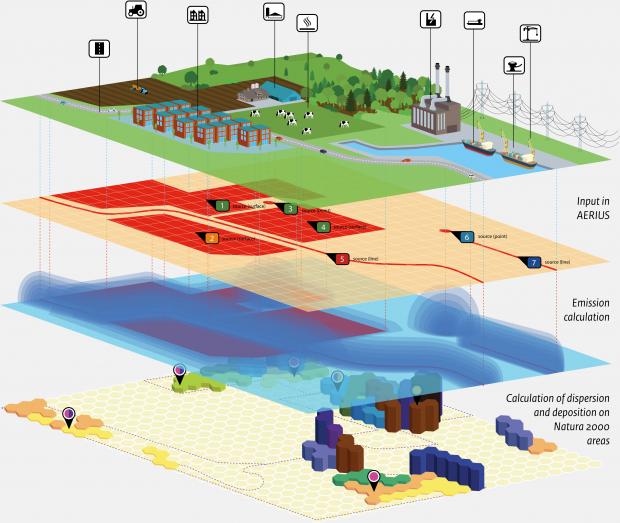The UK AERIUS* project is developing an online integrated air quality assessment tool that can be used to calculate the potential air pollution impacts of development proposals on designated sites and other sensitive habitats. A pilot version of the tool will soon be available for testing and it incorporates improvements that are based on user feedback from a series of workshops held across the UK in April this year.
*UK AERIUS will become known as the UK Air Pollution Assessment Service on launch.
Background
Air pollution, in the form of nitrogen oxides and ammonia emissions, acts as a widespread pressure on semi-natural habitats in Northern Ireland and across the UK. These pollutants are released into the atmosphere from agricultural activities (ammonia), and traffic and industry (nitrogen oxides).
Exposure to these pollutants can have harmful impacts on biodiversity. They can be directly toxic to sensitive plants, or cause excessive nutrient enrichment, resulting in changes in species composition. Excess nitrogen deposition can also affect the ability of habitats to resist disease and adapt to environmental stresses, such as climate change. In Northern Ireland, the ambient ammonia concentrations and nitrogen deposition rates are above the levels that are known to cause harm to biodiversity.
Controlling the amount of excess ammonia and nitrogen reaching habitats relies on risk assessments. These assessments are used to inform planning and permitting decisions about new emission sources. In the UK, there is a range of mechanisms currently used for modelling air pollution and assessing risks to habitats from new development proposals. Relevant information on habitat sensitivities, emission factors and mitigation measures, for example, is held by many different sources and can be difficult to find.
The Integrating Tools for Air Pollution Assessment (ITAPA) project assessed the different approaches in use, and made recommendations for streamlining ecological risk assessment of air pollution in the UK. The project concluded that an integrated tool would provide the best cost-benefit for risk assessment of air pollution effects on ecosystems. An integrated tool should combine screening and detailed air dispersion modelling, incorporate up-to-date emission factors, mitigation measures and habitat data, enabling users to design, test and assess the potential impact of development proposals on the natural environment.
This integrated tool is now in development and it will include Calculator and Register modules. The former will provide detailed modelling that calculates the amount of nitrogen emitted from a proposed development, its dispersion in the air and deposition on protected sites. The Register (to be developed) will facilitate in-combination assessments, taking account of multiple plans that have emission footprints that could act in-combination to potentially increase the effect on sensitive habitats.
Following the completion of the pilot tool, there will be period of quality assurance testing and validation, after which work will begin on the ‘Go Live’ phase, which will see the release of the live tool for use in air quality assessments by applicants, agents, consultancies, advisors and decision makers.
If you wish to find out more information or attend a future workshop, please email the NIEA Natural Environment Division’s Air Quality and Biodiversity Unit at AQBU@daera-ni.gov.uk.

-Source: Flyer for the Calculator element of the tool
Benefits of the tool at a glance
A one-stop shop
National and local emissions will be registered in one place. This ensures better estimates of pollution pressure, so that mitigation is applied in the right locations.
Streamlined sustainable development
The data will be validated and clearly aligned with the approach to risk assessment, which will make decision-making easier and simpler.
Better protection for nature
Information about habitats, their vulnerability and the level of emissions near our sensitive sites will be clear and easily accessible.
Further information
AERIUS | JNCC - Adviser to Government on Nature Conservation (UK)
AERIUS | Calculation tool for the living environment (Netherlands)
Contact us: AQBU@daera-ni.gov.uk
Please click here to view Screenshots of the Pilot Tool.
